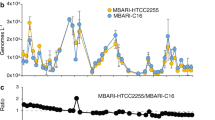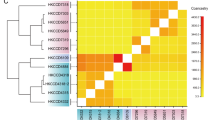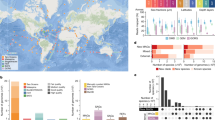Abstract
The vast majority of surface ocean bacteria are uncultivated. Compared with their cultured relatives, they frequently exhibit a streamlined genome, reduced G+C content and distinct gene repertoire. These genomic traits are relevant to environmental adaptation, and have generally been thought to become fixed in marine bacterial populations through selection. Using single-cell genomics, we sequenced four uncultivated cells affiliated with the ecologically relevant Roseobacter clade and used a composition-heterogeneous Bayesian phylogenomic model to resolve these single-cell genomes into a new clade. This lineage has no representatives in culture, yet accounts for ∼35% of Roseobacters in some surface ocean waters. Analyses of multiple genomic traits, including genome size, G+C content and percentage of noncoding DNA, suggest that these single cells are representative of oceanic Roseobacters but divergent from isolates. Population genetic analyses showed that substitution of physicochemically dissimilar amino acids and replacement of G+C-rich to G+C-poor codons are accelerated in the uncultivated clade, processes that are explained equally well by genetic drift as by the more frequently invoked explanation of natural selection. The relative importance of drift vs selection in this clade, and perhaps in other marine bacterial clades with streamlined G+C-poor genomes, remains unresolved until more evidence is accumulated.
Similar content being viewed by others
Log in or create a free account to read this content
Gain free access to this article, as well as selected content from this journal and more on nature.com
or
References
Altschul SF, Madden TL, Schaffer AA, Zhang J, Zhang Z, Miller W et al (1997). Gapped BLAST and PSI-BLAST: a new generation of protein database search programs. Nucleic Acids Res 25: 3389–3402.
Balbi KJ, Rocha EPC, Feil EJ . (2009). The temporal dynamics of slightly deleterious mutations in Escherichia coli and Shigella spp. Mol Biol Evol 26: 345–355.
Bragg JG, Hyder CL . (2004). Nitrogen versus carbon use in prokaryotic genomes and proteomes. P Roy Soc B-Biol Sci 271: S374–S377.
Buchan A, Gonzalez JM, Moran MA . (2005). Overview of the marine Roseobacter lineage. Appl Environ Microbiol 71: 5665–5677.
Capella-Gutiérrez S, Silla-Martínez JM, Gabaldón T . (2009). trimAl: a tool for automated alignment trimming in large-scale phylogenetic analyses. Bioinformatics 25: 1972–1973.
Chen X, Zheng J, Fu Z, Nan P, Zhong Y, Lonardi S et al (2005). Assignment of orthologous genes via genome rearrangement. IEEE T Comp Biol Bioinform 2: 302–315.
Clark MA, Moran NA, Baumann P . (1999). Sequence evolution in bacterial endosymbionts having extreme base compositions. Mol Biol Evol 16: 1586–1598.
Cleland D, Krader P, McCree C, Tang J, Emerson D . (2004). Glycine betaine as a cryoprotectant for prokaryotes. J Microbiol Methods 58: 31–38.
Cox CJ, Foster PG, Hirt RP, Harris SR, Embley TM . (2008). The archaebacterial origin of eukaryotes. Proc Natl Acad Sci USA 105: 20356–20361.
Dayhoff M, Eck R, Park C . (1972). A model of evolutionary change in proteins. In: Dayhoff M. (ed). Atlas of Protein Sequence and Structure. National Biomedical Research Foundation: Silver Spring, MD, USA, pp 89–100.
Dufresne A, Garczarek L, Partensky F . (2005). Accelerated evolution associated with genome reduction in a free-living prokaryote. Genome Biol 6: R14.
Dupont CL, Rusch DB, Yooseph S, Lombardo M-J, Alexander Richter R, Valas R et al (2012). Genomic insights to SAR86 an abundant and uncultivated marine bacterial lineage. ISME J 6: 1186–1199.
Edgar RC . (2004). MUSCLE: multiple sequence alignment with high accuracy and high throughput. Nucleic Acids Res 32: 1792–1797.
Eyre-Walker A, Keightley PD, Smith NGC, Gaffney D . (2002). Quantifying the slightly deleterious mutation model of molecular evolution. Mol Biol Evol 19: 2142–2149.
Foster PG . (2004). Modeling compositional heterogeneity. Syst Biol 53: 485–495.
Foster PG, Cox CJ, Embley TM . (2009). The primary divisions of life: a phylogenomic approach employing composition-heterogeneous methods. Philos Tr Roy Soc B 364: 2197–2207.
Foster PG, Hickey DA . (1999). Compositional bias may affect both DNA-based and protein-based phylogenetic reconstructions. J Mol Evol 48: 284–290.
Galtier N, Gouy M . (1995). Inferring phylogenies from DNA sequences of unequal base compositions. Proc Natl Acad Sci USA 92: 11317–11321.
Ghai R, Rodriguez-Valera F, McMahon KD, Toyama D, Rinke R, Cristina Souza de Oliveira T et al (2011). Metagenomics of the water column in the pristine upper course of the Amazon river. PLoS One 6: e23785.
Giovannoni SJ, Tripp HJ, Givan S, Podar M, Vergin K, Batista D et al (2005). Genome streamlining in a cosmopolitan oceanic bacterium. Science 309: 1242–1245.
Grote J, Thrash JC, Huggett MJ, Landry ZC, Carini P, Giovannoni SJ et al (2012). Streamlining and core genome conservation among highly divergent members of the SAR11 clade. mBio 3: e00252–00212.
Grzymski JJ, Dussaq AM . (2012). The significance of nitrogen cost minimization in proteomes of marine microorganisms. ISME J 6: 71–80.
Gu X, Hewett-Emmett D, Li W-H . (1998). Directional mutational pressure affects the amino acid composition and hydrophobicity of proteins in bacteria. Genetica 102/103: 383–391.
Herbeck JT, Degnan PH, Wernegreen JJ . (2005). Nonhomogeneous model of sequence evolution indicates independent origins of primary endosymbionts within the Enterobacteriales. (γ-Proteobacteria). Mol Biol Evol 22: 520–532.
Hershberg R, Petrov DA . (2010). Evidence that mutation Is universally biased towards AT in bacteria. PLoS Genet 6: e1001115.
Hildebrand F, Meyer A, Eyre-Walker A . (2010). Evidence of selection upon genomic GC-content in bacteria. PLoS Genet 6: e1001107.
Hrdy I, Hirt RP, Dolezal P, Bardonova L, Foster PG, Tachezy J et al (2004). Trichomonas hydrogenosomes contain the NADH dehydrogenase module of mitochondrial complex I. Nature 432: 618–622.
Hu J, Blanchard JL . (2009). Environmental sequence data from the Sargasso Sea reveal that the characteristics of genome reduction in Prochlorococcus are not a harbinger for an escalation in genetic drift. Mol Biol Evol 26: 5–13.
Hughes AL . (1999) Adaptive evolution of genes and genomes. Oxford University Press: NY, USA.
Hughes AL . (2008). Near neutrality: leading edge of the neutral theory of molecular evolution. Ann NY Acad Sci 1133: 162–179.
Hughes AL . (2009). Relaxation of purifying selection on live attenuated vaccine strains of the family. Paramyxoviridae. Vaccine 27: 1685–1690.
Hughes AL . (2013). Accumulation of slightly deleterious mutations in the mitochondrial genome: a hallmark of animal domestication. Gene 515: 28–33.
Hughes AL, Friedman R . (2009). More radical amino acid replacements in primates than in rodents: support for the evolutionary role of effective population size. Gene 440: 50–56.
Hughes AL, Ota T, Nei M . (1990). Positive Darwinian selection promotes charge profile diversity in the antigen-binding cleft of class I major-histocompatibility-complex molecules. Mol Biol Evol 7: 515–524.
Jermiin LS, Ho SYW, Ababneh F, Robinson J, Larkum AWD . (2004). The biasing effect of compositional heterogeneity on phylogenetic estimates may be underestimated. Syst Biol 53: 638–643.
Kass RE, Raftery AE . (1995). Bayes factors. J Amer Stat Assoc 90: 773–795.
Katoh K, Kuma K-i, Toh H, Miyata T . (2005). MAFFT version 5: improvement in accuracy of multiple sequence alignment. Nucleic Acids Res 33: 511–518.
Kumar S, Stecher G, Peterson D, Tamura K . (2012). MEGA-CC: computing core of molecular evolutionary genetics analysis program for automated and iterative data analysis. Bioinformatics 28: 2685–2686.
Kuo C-H, Moran NA, Ochman H . (2009). The consequences of genetic drift for bacterial genome complexity. Genome Res 19: 1450–1454.
Lauro FM, McDougald D, Thomas T, Williams TJ, Egan S, Rice S et al (2009). The genomic basis of trophic strategy in marine bacteria. Proc Natl Acad Sci USA 106: 15527–15533.
Lewis P, Holder M, Holsinger K . (2005). Polytomies and Bayesian phylogenetic inference. Syst Biol 54: 241–253.
Li L, Stoeckert CJ, Roos DS . (2003). OrthoMCL: identification of ortholog groups for eukaryotic genomes. Genome Res 13: 2178–2189.
Lind PA, Andersson DI . (2008). Whole-genome mutational biases in bacteria. Proc Natl Acad Sci USA 105: 17878–17883.
Löytynoja A, Goldman N . (2008). Phylogeny-aware gap placement prevents errors in sequence alignment and evolutionary analysis. Science 320: 1632–1635.
Luo H, Csürös M, Hughes AL, Moran MA . (2013). Evolution of divergent ecological strategies in marine Alphaproteobacteria. mBio 4: mBio 00373–13.
Luo H, Hughes AL . (2012). dN/dS does not show positive selection drives separation of polar-tropical SAR11 populations. Mol Syst Biol 8: 625.
Luo H, Friedman R, Tang J, Hughes AL . (2011a). Genome reduction by deletion of paralogs in the marine cyanobacterium. Prochlorococcus. Mol Biol Evol 28: 2751–2760.
Luo H, Löytynoja A, Moran MA . (2012). Genome content of uncultivated marine Roseobacters in the surface ocean. Environ Microbiol 14: 41–51.
Luo H, Tang J, Friedman R, Hughes AL . (2011b). Ongoing purifying selection on intergenic spacers in group A streptococcus. Infect Genet Evol 11: 343–348.
Martin-Cuadrado A-B, Rodriguez-Valera F, Moreira D, Alba JC, Ivars-Martinez E, Henn MR et al (2008). Hindsight in the relative abundance metabolic potential and genome dynamics of uncultivated marine archaea from comparative metagenomic analyses of bathypelagic plankton of different oceanic regions. ISME J 2: 865–886.
McCutcheon JP, Moran NA . (2012). Extreme genome reduction in symbiotic bacteria. Nat Rev Micro 10: 13–26.
Miyata T, Miyazawa S, Yasunaga T . (1979). Two types of amino acid substitutions in protein evolution. J Mol Evol 12: 219–236.
Moran MA, Belas R, Schell MA, Gonzalez JM, Sun F, Sun S et al (2007). Ecological genomics of marine Roseobacters. Appl Environ Microbiol 73: 4559–4569.
Moran MA, Buchan A, Gonzalez JM, Heidelberg JF, Whitman WB, Kiene RP et al (2004). Genome sequence of Silicibacter pomeroyi reveals adaptations to the marine environment. Nature 432: 910–913.
Morris JJ, Lenski RE, Zinser ER . (2012). The black queen hypothesis: evolution of dependencies through adaptive gene loss. mBio 3: e00036–00012.
Nei M . (1987) Molecular evolutionary genetics. Columbia University Press: NY, USA.
Nei M, Suzuki Y, Nozawa M . (2010). The neutral theory of molecular evolution in the genomic era. Ann Rev Genom Hum G 11: 265–289.
Nesnidal MP, Helmkampf M, Bruchhaus I, Hausdorf B . (2010). Compositional heterogeneity and phylogenomic inference of metazoan relationships. Mol Biol Evol 27: 2095–2104.
Newton MA, Raftery AE . (1994). Approximate bayesian inference with the weighted likelihood bootstrap. J R Stat Soc 56: 3–56.
Newton RJ, Griffin LE, Bowles KM, Meile C, Gifford S, Givens CE et al (2010). Genome characteristics of a generalist marine bacterial lineage. ISME J 4: 784–798.
Notredame C, Higgins D, Heringa J . (2000). T-coffee: a novel method for fast and accurate multiple sequence alignment. J Mol Biol 302: 205–217.
Ochman H, Elwyn S, Moran NA . (1999). Calibrating bacterial evolution. Proc Natl Acad Sci USA 96: 12638–12643.
Ohta T . (1992). The nearly neutral theory of molecular evolution. Ann Rev Ecol Syst 23: 263–286.
Pruitt KD, Tatusova T, Klimke W, Maglott DR . (2009). NCBI Reference Sequences: current status policy and new initiatives. Nucleic Acids Res 37: D32–D36.
Raghavan R, Kelkar YD, Ochman H . (2012). A selective force favoring increased G+C content in bacterial genes. Proc Natl Acad Sci USA 109: 14504–14507.
Rocap G, Larimer FW, Lamerdin J, Malfatti S, Chain P, Ahlgren NA et al (2003). Genome divergence in two Prochlorococcus ecotypes reflects oceanic niche differentiation. Nature 424: 1042–1047.
Rodriguez-Brito B, Rohwer F, Edwards RA . (2006). An application of statistics to comparative metagenomics. BMC Bioinformatics 7: 162.
Rusch DB, Halpern AL, Sutton G, Heidelberg KB, Williamson S, Yooseph S et al (2007). The Sorcerer II Global Ocean Sampling Expedition: Northwest Atlantic through Eastern Tropical Pacific. PLoS Biol 5: e77.
Singer GAC, Hickey DA . (2000). Nucleotide bias causes a genomewide bias in the amino acid composition of proteins. Mol Biol Evol 17: 1581–1588.
Swan BK, Tupper B, Sczyrba A, Lauro FM, Martinez-Garcia M, González JM et al (2013). Prevalent genome streamlining and latitudinal divergence of marine bacteria in the surface ocean. Proc Natl Acad Sci USA 110: 11463–11468.
Tatusov RL, Koonin EV, Lipman DJ . (1997). A genomic perspective on protein families. Science 278: 631–637.
Wernegreen JJ . (2011). Reduced selective constraint in endosymbionts: elevation in radical amino acid replacements occurs genome-wide. PLoS One 6: e28905.
Wernegreen JJ, Moran NA . (1999). Evidence for genetic drift in endosymbionts. (Buchnera): analyses of protein-coding genes. Mol Biol Evol 16: 83–97.
Woyke T, Xie G, Copeland A, González JM, Han C, Kiss H et al (2009). Assembling the marine metagenome, one cell at a time. PLoS One 4: e5299.
Yooseph S, Nealson KH, Rusch DB, McCrow JP, Dupont CL, Kim M et al (2010). Genomic and functional adaptation in surface ocean planktonic prokaryotes. Nature 468: 60–66.
Zhang J . (2000). Rates of conservative and radical nonsynonymous nucleotide substitutions in mammalian nuclear genes. J Mol Evol 50: 56–68.
Zhao Y, Tang H, Ye Y . (2012). RAPSearch2: a fast and memory-efficient protein similarity search tool for next-generation sequencing data. Bioinformatics 28: 125–126.
Zuckerkandl E, Pauling L . (1965). Evolutionary divergence and convergence in proteins. In: Bryson V, Vogel H. (eds). Evolving Genes and Proteins. Academic Press: NY, USA, pp 97–116.
Acknowledgements
We thank A Rivers, B Satinsky and B Durham for comments on an earlier version of the manuscript, P Foster for advice on P4 phylogenetic analysis, S Sharma and Y Huang for help with bioinformatics, C English for assistance with graphics, three anonymous reviewers for constructive comments and the Georgia Advanced Computing Resource Center at the University of Georgia for computational resources. This research was funded by grants from the Gordon and Betty Moore Foundation and the National Science Foundation (MCB-0702125).
Author information
Authors and Affiliations
Corresponding author
Ethics declarations
Competing interests
The authors declare no conflict of interest.
Additional information
Supplementary Information accompanies this paper on The ISME Journal website
Rights and permissions
About this article
Cite this article
Luo, H., Swan, B., Stepanauskas, R. et al. Evolutionary analysis of a streamlined lineage of surface ocean Roseobacters. ISME J 8, 1428–1439 (2014). https://doi.org/10.1038/ismej.2013.248
Received:
Revised:
Accepted:
Published:
Issue date:
DOI: https://doi.org/10.1038/ismej.2013.248
Keywords
This article is cited by
-
Mechanisms driving genome reduction of a novel Roseobacter lineage
The ISME Journal (2021)
-
Marine Dadabacteria exhibit genome streamlining and phototrophy-driven niche partitioning
The ISME Journal (2021)
-
Pyropia yezoensis genome reveals diverse mechanisms of carbon acquisition in the intertidal environment
Nature Communications (2020)
-
Spontaneous mutations of a model heterotrophic marine bacterium
The ISME Journal (2017)
-
Excess of non-conservative amino acid changes in marine bacterioplankton lineages with reduced genomes
Nature Microbiology (2017)



